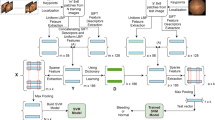Abstract
Digestive tract examination has now become painless and simple with the aid of wireless capsule endoscopy (WCE). By continuously imaging and transmitting the patient’s gastrointestinal tract, the capsule can store thousands of endoscopic images for medical diagnosis. The problem is that a large number of images generated in the near-time period are near-reduplicate and are therefore time-consuming for a medical expert to inspect. In this paper, we tackle this problem by proposing an online redundant image elimination system. Computer vision–based primitive features are first explored and compared to represent WCE images. A spatial sensitive version is then introduced to enhance the description. After determining the dissimilarity between neighboring images with a suitable measure, real-time and image-buffered versions of peak detection–based elimination algorithms are proposed to retain the distinctive/interesting images in the examination. Comparison results of primitive features and their spatial sensitive approaches via several probabilistic dissimilarity measures demonstrate that they are descriptive and efficient. Also, experiments performed on both the testing and the large real datasets show that the proposed elimination algorithms are effective, flexible and robust.







Similar content being viewed by others
References
Money, A.G., Agius, H.: Video summarisation: a conceptual framework and survey of the state of the art. J. Vis. Commun. Image Represent. 19(2), 121–143 (2000)
Iddan, G., Meron, G., Glukhovsky, A., Swain, P.: Wireless capsule endoscopy. Nature 405(6785), 417–418 (2000)
Chu, X., Poh, C.K., Li, L., Chan, K.L., Yan, S., Shen, W., Htwe, T.M., Liu, J., Lim, J., Ong, E.H.: Epitomized summarization of wireless capsule endoscopic videos for efficient visualization. In: Proceedings of MICCAI, pp. 522–529 (2010)
Iakovidis, D.K., Tsevas, S., Polydorou, A.: Reduction of capsule endoscopy reading times by unsupervised image mining. Comput. Med. Imaging Graph. 34(6), 471–478 (2010)
Simakov, D., Caspi, Y., Shechtman, E., Irani, M.: Summarizing visual data using bidirectional similarity. In: Proceedings of CVPR, pp. 1–8 (2008)
Berens, J., Mackiewicz, M., Bell, D.: Stomach, intestine and colon tissue discriminators for wireless capsule endoscopy images. In: Proceedings of SPIE, progress in biomedical optics and imaging, 5747, pp. 283–290 (2005)
Kodogiannis, V.S., Boulougoura, M.: Neural network-based approach for the classification of wireless-capsule endoscopic images. In: Proceedings of international joint conference on neural networks, 4, pp. 2423–2428 (2005)
Lee, J., Oh, J., Shah, S.K., Yuan, X., Tang, S.J.: Automatic classification of digestive organs in wireless capsule endoscopy videos. In: Proceedings of ACM symposium on applied computing, pp. 1041–1045 (2007)
Bourbakis, N.: Detecting abnormal patterns in WCE images. In: Proceedings of IEEE symposium on bioinformatics and, bioengineering, pp. 232–238 (2005)
Li, B., Meng, M.Q.H.: Computer-based detection of bleeding and ulcer in wireless capsule endoscopy images by chromaticity moments. Comput. Biol. Med. 39(2), 141–147 (2009)
Hwang, S., Oh, J., Cox, J., Tang, S.J., Tibbals, H.F.: Blood detection in wireless capsule endoscopy using expectation maximization clustering. In: Proceedings of SPIE, progress in biomedical optics and imaging 6144, pp. 577–587 (2006)
Karargyris, A.: Detection of small bowel polyps and ulcers in wireless capsule endoscopy videos. In: IEEE Trans. Biomed. Eng. 58(10), 2777–2786 (2011)
Karargyris, A., Bourbakis, N.: Three-dimensional reconstruction of the digestive wall in capsule endoscopy videos using elastic video interpolation. In: IEEE Trans. Med. Imaging 30(4), 957–971 (2011)
Szczypiński, P.M., Sriram, R.D., Sriram, P.V., Reddy, D.N.: A model of deformable rings for interpretation of wireless capsule endoscopic videos. Med. Image Anal. 13(2), 312–324 (2009)
Ciuti, G.: Capsule endoscopy: from current achievements to open challenges. In: IEEE Rev. Biomed. Eng. 4, 59–72 (2011)
Ojala, T., Pietikainen, M., Maenpaa, T.: Multiresolution gray-scale and rotation invariant texture classification with local binary patterns. In: IEEE Trans. Pattern Anal. Mach. Intell. 24(7), 971–987 (2002)
Manjunath, B.S., Ohm, J., Vasudevan, V.V., Yamada, A.: Color and texture descriptors. In: IEEE Trans. Circuits Syst. Video Technol. 11(6), 703–715 (2001)
Park, D.K., Jeon, Y.S., Won, C.S.: Efficient use of local edge histogram descriptor. In: Proceedings of ACM multimedia workshops, pp. 51–54 (2000)
Lazebnik, S., Schmid, C., Ponce, J.: Beyond bags of features: spatial pyramid matching for recognizing natural scene categories. In: Proceedings of CVPR, pp. 2169–2178 (2006)
Cao, Y., Wang, C., Li, Z., Zhang, L., Zhang, L.: Spatial-bag-of-features. In: Proceedings of CVPR, pp. 3352–3359 (2010)
Tsallis, C.: Possible generalization of Boltzmann-Gibbs statistics. J. Stat. Phys. 52, 479–487 (1988)
Lin, J.: Divergence measures based on the Shannon entropy. In: IEEE Trans. Inf. Theory 37(1), 145–151 (1991)
Mohamed, W., Zhang, W.Y., Ben Hamza, A., Bouguila, N.: Stochastic optimization approach for entropic image alignment”. In: Proceedings of IEEE international symposium on information theory, pp. 2126–2130 (2008)
Acknowledgments
The authors would like to thank the anonymous reviewers for helpful and very insightful comments. This work first started as part of a project when the first author was doing his internship at Ankon Technology Inc. The concepts of primary image feature representation, circle-based spatial partition and near-real-time elimination algorithm were developed in the company.
Author information
Authors and Affiliations
Corresponding author
Rights and permissions
About this article
Cite this article
Li, C., Hamza, A.B., Bouguila, N. et al. Online redundant image elimination and its application to wireless capsule endoscopy. SIViP 8, 1497–1506 (2014). https://doi.org/10.1007/s11760-012-0384-3
Received:
Revised:
Accepted:
Published:
Issue Date:
DOI: https://doi.org/10.1007/s11760-012-0384-3




